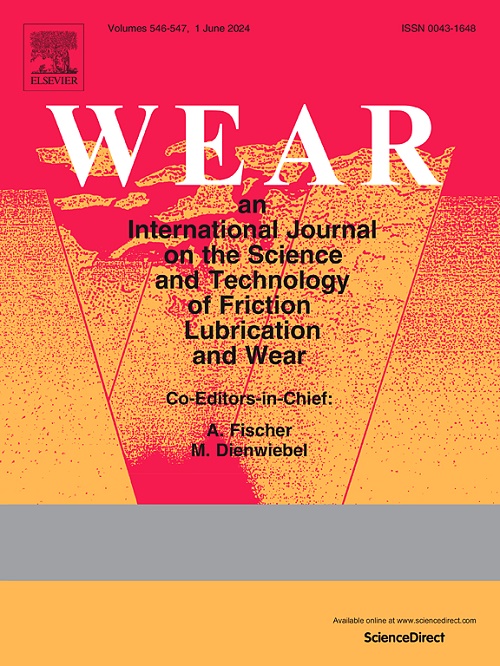Influence of multi directional forging-induced grain refinement and subsequent aging on tribological performance of Cu-Ni-Si-Cr alloys in electrical contact sliding conditions
IF 5.3
1区 工程技术
Q1 ENGINEERING, MECHANICAL
引用次数: 0
Abstract
This study examines the effect of deformation-induced grain refinement on the tribological behavior of CuNi2SiCr alloys under electrical current-carrying contact conditions of 0A, 5A, 15A, and 25A. The results demonstrate that the formation of an ultrafine-grained (UFG) structure in the matrix enhanced the wear resistance of the alloy in all test conditions. The improvement in wear resistance is more pronounced under electrical contact sliding conditions. With the formation of the UFG structure, the wear volume loss decreased by 18 % compared to the coarse-grained (CG) sample under currentless conditions. The decrease seen in volumetric loss is achieved as 27 %, 42 %, and 67 % for conditions of 5A, 15A, and 25A, respectively. Additionally, as the intensity of electric current increases, the average friction coefficient value of the samples rises, exhibiting significant fluctuations during the steady-state period of rubbing with increasing electric current intensity. Furthermore, the dominant wear mechanism depends on the level of electrical current intensity. While adhesive, abrasive, and oxidative wear mechanisms are operative for coarse (CG) and UFGed CuNi2SiCr samples at low-intensity electrical current conditions, arc-induced erosion, oxidative, and severe abrasive-based wear are more active at higher current intensities for both samples.
多向锻造致晶粒细化及后续时效对Cu-Ni-Si-Cr合金电接触滑动摩擦性能的影响
本文研究了在0A、5A、15A和25A载电流接触条件下,变形诱导晶粒细化对CuNi2SiCr合金摩擦学行为的影响。结果表明,在基体中形成超细晶(UFG)组织,增强了合金的耐磨性。在电接触滑动条件下,耐磨性的提高更为明显。随着UFG结构的形成,在当前条件下,与粗晶(CG)样品相比,磨损体积损失降低了18%。在5A、15A和25A条件下,体积损失分别减少27%、42%和67%。另外,随着电流强度的增大,试样的平均摩擦系数增大,在摩擦稳态期间随着电流强度的增大出现明显的波动。此外,主要的磨损机制取决于电流强度的水平。虽然在低强度电流条件下,黏合剂、磨料和氧化磨损机制对粗(CG)和UFGed CuNi2SiCr样品有效,但在高电流条件下,电弧侵蚀、氧化和严重的磨料磨损对这两种样品都更有效。
本文章由计算机程序翻译,如有差异,请以英文原文为准。
求助全文
约1分钟内获得全文
求助全文
来源期刊

Wear
工程技术-材料科学:综合
CiteScore
8.80
自引率
8.00%
发文量
280
审稿时长
47 days
期刊介绍:
Wear journal is dedicated to the advancement of basic and applied knowledge concerning the nature of wear of materials. Broadly, topics of interest range from development of fundamental understanding of the mechanisms of wear to innovative solutions to practical engineering problems. Authors of experimental studies are expected to comment on the repeatability of the data, and whenever possible, conduct multiple measurements under similar testing conditions. Further, Wear embraces the highest standards of professional ethics, and the detection of matching content, either in written or graphical form, from other publications by the current authors or by others, may result in rejection.
 求助内容:
求助内容: 应助结果提醒方式:
应助结果提醒方式:


